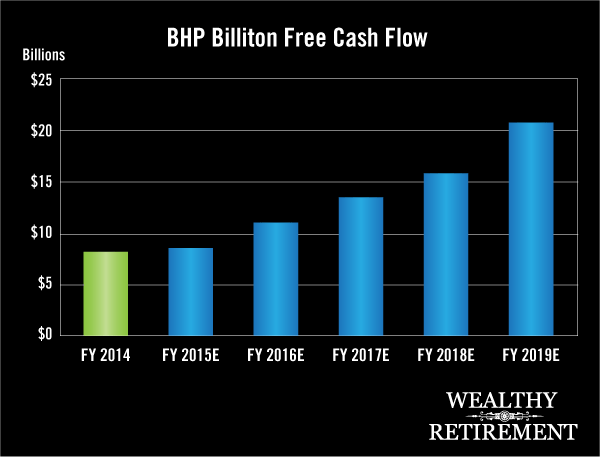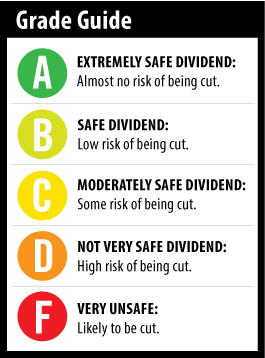 Longtime reader and frequent contributor to the comments section T-Bone appears to be licking his chops after the huge decline in BHP Billiton PLC (NYSE: BBL).
Longtime reader and frequent contributor to the comments section T-Bone appears to be licking his chops after the huge decline in BHP Billiton PLC (NYSE: BBL).
Let’s take a look at the U.K.-based metals miner.
BHP Billiton PLC and BHP Billiton Limited (NYSE: BHP) are two separate legal entities, but the same economic organization. They share the same financial statements, and simply trade as separate stocks.
[ad#Google Adsense 336×280-IA]For the purpose of this analysis, we’ll use BBL, since that was the symbol that T-Bone requested.
But the same conclusion goes for BHP.
BHP Billiton is one of the world’s largest miners.
If it’s in the ground, BHP Billiton probably mines it.
It is especially known for being a major producer of iron ore, which is the main component of steel.
Because of the stock’s 20% decline in just two months and its recently raised dividend, BHP Billiton sports an attractive 4.2% yield.
The company has raised its dividend every year since it started paying one in 2003. Over the past 10 years, the dividend has risen by a compound annual growth rate of 21%. But the big boosts were in the early years. Over the past five years, the dividend growth rate has been a more sustainable 9%. In 2014, the company raised the dividend by 8%.
Tough Times
The metals miners have had a tough go of it lately as prices have plummeted – down 42% this year. Iron ore is at a five-year low with few analysts expecting a recovery due to slowing growth in China and ample supply.
As a result, Wall Street expects BHP Billiton’s earnings per share to slide from $2.54 in fiscal 2014, which ended in June, to $2.41 next year.
However, even though profits will decline, free cash flow is forecast to rise thanks to lower capital expenditures (capex).
 In fiscal 2014, free cash flow came in at $8.4 billion. Thanks to nearly $3 billion less in capex, free cash flow is projected to rise to $8.9 billion in fiscal 2015, and then climb substantially for the next four years until it hits $20.5 billion in 2019.
In fiscal 2014, free cash flow came in at $8.4 billion. Thanks to nearly $3 billion less in capex, free cash flow is projected to rise to $8.9 billion in fiscal 2015, and then climb substantially for the next four years until it hits $20.5 billion in 2019.
In fiscal 2014, the company paid out $6.4 billion in dividends for a payout ratio of 76%, right at the limit of my comfort level. Generally speaking, I like to see a payout ratio of 75% or lower.
If capital expenditures were not expected to decrease, I would be concerned about whether the company would be able to continue to raise the dividend, or even sustain it in the event that iron ore prices continue to fall.
But as long as the company is still planning to eliminate capex costs, there should be plenty of free cash flow to pay the dividend.
For example, if the company increased its dividends paid by 10% this fiscal year, the payout ratio would be 80%, which would concern me. But the following year, free cash flow is expected to spike to over $11 billion, giving us plenty of room for a meaningful dividend raise.
Furthermore, the company has a stated dividend policy of seeking to “steadily increase or at least to maintain the dividend in U.S. dollars at each half yearly payments.”
If BHP Billiton had no stated policy and no track record, the payout ratio would be of concern. But considering it has a 10-year track record of annual dividend raises, a policy to grow the dividend, and should have plenty of free cash flow to raise the dividend in the near future, I’m not worried about the company cutting the dividend anytime soon.
 Worst-case scenario, it maintains the dividend in fiscal 2015. But even that is unlikely.
Worst-case scenario, it maintains the dividend in fiscal 2015. But even that is unlikely.
I suspect management will find a way to raise the dividend even if the next 12 months get more difficult.
My colleague Sean Brodrick, Editor of The Oxford Club’s Oxford Resource Explorer, agrees.
When I reached out to him about his thoughts on BHP Billiton, he replied, “The dividend yield is unlikely to be compromised.”
I’ll say it even stronger. It won’t be compromised.
Dividend Safety Rating: A
— Marc Lichtenfeld
[ad#sa-income]
Source: Wealthy Retirement

